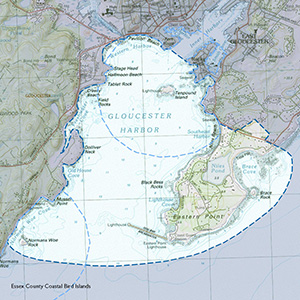Important Bird Area Sites in Massachusetts
Important Bird Area: Eastern Point/Gloucester Harbor
Site Summary
Nominated By
Chris Leahy
Size
400-500 (not including boundary waters) acres
Towns and Counties
Gloucester; Essex
Ownership
federal military, municipal, private, Mass Audubon
Major Habitats
30% urban/suburban, 12% lake/pond, 15 % coastal beach, 8% oak-conifer transitional forest, 8% salt marsh, 8% coastal successional shrubland, 8% palustrine wooded swamp, 5% shrub-scrub wetland, 4% cultural grassland, 2% emergent freshwater wetland
Land Use
nature & wildlife conservation/land trust, fishing, other recreation or tourism, fisheries/aquaculture, utility/right-of-way, suburban/residential, military
Serious Threats
non-native, invasive plants, introduced animals or feral pets, cowbird parasitism, succession, residential/commercial development, disturbance to birds or habitat, recreational development/overuse
IBA Criteria
- Category 4: Sites containing assemblages of species characteristic of a representative, rare, threatened, or unique habitat within the state or region.
Site Description
Eastern Point is the southeastern tip of the East Gloucester peninsula from Farrington Ave. southwestward to the tip of the peninsula; it encompasses adjacent tidal flats and open water of Gloucester Harbor to the west and Brace Cove and nearshore waters of the Atlantic Ocean to the east. It contains an unusual diversity of bird habitats as described below, and is one of the best known "migrant traps" in Essex County. Special features include Niles Pond, a 34-acre pond that attracts a wide variety of waterbirds during most of the year; Brace Cove, a sheltered inlet of the Atlantic Ocean that harbors waterfowl as well as a surprising variety (although never large numbers) of shorebirds on its tidal beach and cobble shores; and linked parcels of oak woods, wooded and shrub swamp, and upland shrub-scrub habitat in various stages of succession. The shallow waters surrounding the peninsula support significant numbers of migratory and wintering seabirds and waterfowl, especially from October to May. Over 250 bird species have been recorded from this approximately 2-mile-long peninsula.
Current Conservation Status
This is a suburban neighborhood adjacent to a small city with a working harbor, and all of the threats are essentially of human origin. Land protection has been the major abatement technique, and a significant percentage of the peninsula is owned by Mass Audubon. There is presently a narrow window in which to protect significant remaining tracts of undisturbed open space that are critical to the ecological integrity of the whole. Other conservation strategies are increasing awareness of the area as important area for birds and other wildlife. Recreational and commercial use of the surrounding waters is increasing and brings concomitant threats of pollution and disturbance.
A tidal restriction was created by the road accessing the Coast Guard Station and Dogbar Breakwater at the south point, resulting in degradation of the salt marsh. This includes invasion by Common Reed and Purple Loosestrife. The former is also encroaching rapidly on Niles Pond, one of the most significant natural features of the site. The salt marsh was also ditched for mosquito control. A plan is currently being prepared for restoration of this marsh. Other invasives that are very common in the upland habitats of Eastern Point include European Buckthorn, Oriental Bittersweet, Tartarian Honeysuckle, and Japanese Barberry.
Ornithological Significance
While Eastern Point may not score high by any single criterion, I believe that it represents an unusual concentration of diverse habitats, which in turn serves a broad spectrum of bird species, including a number of high conservation priorities in Massachusetts. Much of the site is already protected, but opportunities remain to add unfragmented habitat to existing protected land; an IBA designation would underscore the importance of protecting more of the site.
Category 1: Small numbers annually at Eastern Point as migrants: Common Loon (also winters), Pied-billed Grebe, Sharp-shinned Hawk, Northern Harrier, Peregrine Falcon, Common Tern, Least Tern, Northern Parula, Blackpoll Warbler, and Mourning Warbler.
Category 2: The following high-conservation-priority species occur on Eastern Point annually: Snowy Egret, Black-crowned Night-Heron (small roost); American Black Duck (breeds), American Kestrel (has bred?), Willet, Solitary Sandpiper, Whimbrel, Ruddy Turnstone, Sanderling, Short-billed Dowitcher, American Woodcock (breeds), Chimney Swift (breeds), Hairy Woodpecker, Eastern Wood-Pewee, Olive-sided Flycatcher, Least Flycatcher, Eastern Phoebe (breeds), Great Crested Flycatcher (breeds), Eastern Kingbird (breeds), Cliff Swallow (breeds), Gray Catbird (very common breeder, common to occasionally abundant migrant), Wood Thrush (has bred?), Veery, Swainson's Thrush, Brown Thrasher (breeds), Blue-winged Warbler, Chestnut-sided Warbler, Black-throated Blue Warbler, Black-throated Green Warbler, Blackburnian Warbler, Prairie Warbler, Black-and-white Warbler (breeds?), American Redstart (breeds), Worm-eating Warbler, Canada Warbler, Indigo Bunting, Eastern Towhee (breeds), Field Sparrow, White-throated Sparrow, Rose-breasted Grosbeak, Bobolink, Scarlet Tanager, and Baltimore Oriole (breeds).
Category 3a: Nearshore waters surrounding Eastern Point in late fall to early spring support significant numbers of Black Guillemots and sometimes other alcids. High totals for wintering/roosting gulls (mainly Herring and Great Black-backed) certainly approach (if not exceed) the criteria threshold, and concentrations of less common gulls are also frequent.
Category 3c: Concentrations of waterfowl in surrounding waters (Gloucester's outer harbor and the "back shore") and in Niles Pond frequently exceed 500 birds from late fall to early spring.
Category 3f: More than 90 species of migratory land birds (passerines) are recorded annually at Eastern Point; total for all species of perching birds exceeds 100 species. As a rule, species do not occur in exceptionally high numbers.
Category 4: One of the dominant habitat types at Eastern Point is coastal shrub-scrub thickets that support Gray Catbirds (very common breeder; occasionally abundant migrant), Brown Thrasher (uncommon breeder), and Eastern Towhee (fairly common breeder), all high-conservation-priority species.
Other Flora or Fauna of Significance
There is a perennial Monarch roost site near the south end of the peninsula. A small dune system along the shore supports a stand of a species of Sea Lyme-Grass (state Endangered) at or near the southern-most extent of its range.
Data Sources
C. Leahy, personal observation 1950's to present; records of local and other birders; waterfowl surveys from MassWildlife and Mass Audubon, Christmas Bird Counts




